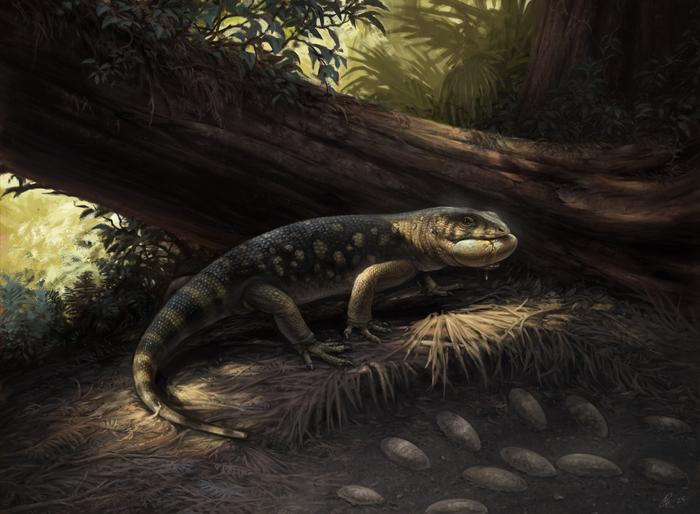Now Reading: Newly Identified Monstersaur Lizard Had an Armored Skull and Walked Among Dinosaurs
-
01
Newly Identified Monstersaur Lizard Had an Armored Skull and Walked Among Dinosaurs
Newly Identified Monstersaur Lizard Had an Armored Skull and Walked Among Dinosaurs

A newly identified armored monstersaurian lizard roamed Grand Staircase-Escalante National Monument in Utah during the Age of Dinosaurs. About the size of a raccoon, this large lizard was an ancestor of the Gila monster — a venomous lizard found in the American Southwest and Northwest Mexico.
Little is known about the large lizards of that time, but this new discovery helps shed light on the creatures’ diversity and how they may have traversed the continent to get to where they were. Featured in a new study published in Royal Society Open Science, the researchers have named the prehistoric lizard Bolg amondol after a character in J.R.R. Tolkien’s The Hobbit.
Rediscovering Large-Bodied Lizards
Hank Woolley, a researcher at the Natural History Museum of Los Angeles County’s Dinosaur Institute and the lead author of the study, rediscovered the fossil in the archives of the Natural History Museum of Utah.
“I opened this jar of bones labeled ‘lizard’ at the Natural History Museum of Utah, and was like, oh wow, there’s a fragmentary skeleton here,” said Woolley in a press release. “We know very little about large-bodied lizards from the Kaiparowits Formation in Grand Staircase-Escalante National Monument in Utah, so I knew this was significant right away.”
The research team identified Bolg amondol from various pieces of its vertebrae, skull, limbs, girdles, and bony armor known as osteoderms. According to the study, most of the remains of these large lizards are fragments, but Bolg is different.
“What’s really interesting about this holotype specimen of Bolg is that it’s fragmentary, yes, but we have a broad sample of the skeleton preserved,” Woolley says. “There’s no overlapping bones — there’s not two left hip bones or anything like that. So we can be confident that these remains likely belonged to a single individual.”
Read More: Meet Khankhuuluu: The Dragon Prince Dinosaur That Came Before T. Rex
Uncovering Monstersaurian History
LEFT IMAGE: Publicly available rendered CT scan of Heloderma horridum (UF:Herp:153328) from morphosource.org used for comparison to Bolg amondol, with mound-like, polygonal osteoderms in green. RIGHT IMAGE: Skull of the modern monstersaur Heloderma horridum (LACM 159136), from the herpetology collection at NHMLAC, used for comparison with Bolg amondol. (Image Credit: Dr. Hank Woolley)
According to the research team, this discovery helps paint a better picture of what the ecosystem was like at that time. There were likely three of these large, predatory lizard species that lived in the region, and the climate would have been seasonally tropical with lush forests compared to the desert it is today.
These lizards also likely had pitted, polygonal armor on their skulls and spire-like teeth. According to the study, we’d probably think of these lizards as monsters today.
“Three feet tip to tail, maybe even bigger than that, depending on the length of the tail and torso,” said Woolley in a press release. “So by modern lizard standards, a very large animal, similar in size to a Savannah monitor lizard; something that you wouldn’t want to mess around with.”
This discovery also highlights that there is more to discover about these prehistoric lizards. The closest known relative of Bolg hails from the Gobi Desert in Asia. And while it is known to science that dinosaurs traversed continents, these new findings indicate that smaller animals may have traversed continents as well.
Naming the Monster Lizard
When coming up with a name, Woolley wanted to ensure it was appropriate for a monstersaur. So naturally, he thought of J.R.R. Tolkien, an expert at creating monsters.
“Bolg is a great-sounding name. It’s a goblin prince from The Hobbit, and I think of these lizards as goblin-like, especially looking at their skulls,” Woolley said in a press release.
Using Sindarin, the language Tolkien crafted for the elves, Woolley built the rest of the name. “Amon” is the Elvish word for “mound,” and “dol” translates to “head.” This refers to the mound-like osteoderms on Bolg’s skull. Bolg amondol translates to “Mound-Headed Bolg.”
Like the treasures that dwell in Toliken’s stories, there is still much to discover in the fossil archives of these museums, perhaps even another monstersaur.
Read More: New Species of Frog Named After the Hobbit Author, J.R.R. Tolkien
Article Sources
Our writers at Discovermagazine.com use peer-reviewed studies and high-quality sources for our articles, and our editors review for scientific accuracy and editorial standards. Review the sources used below for this article:
-
Royal Society Open Science. New monstersaur specimens from the Kaiparowits Formation of Utah reveal unexpected richness of large-bodied lizards in Late Cretaceous North America
A graduate of UW-Whitewater, Monica Cull wrote for several organizations, including one that focused on bees and the natural world, before coming to Discover Magazine. Her current work also appears on her travel blog and Common State Magazine. Her love of science came from watching PBS shows as a kid with her mom and spending too much time binging Doctor Who.























